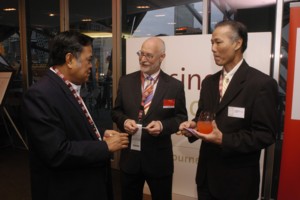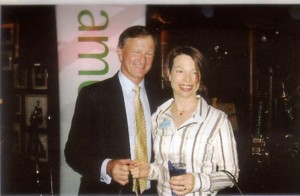


Testimonials - click here
Published Articles - click here
Businees Club Australia Melbourne 2006
Endorsed by the Melbourne 2006 Commonwealth Games Corporation, Business Club Australia: Melbourne 2006 generated business opportunities around the Games through business matching, strategic meetings and networking events
The Malaysia and Singapore networking event was attended by the High Commissioner for Malaysia
photo left to right:
Salim Hashim, High Commissioner of Malaysia, Ian Newgreen, Director PRIORITY
ONE TRAINING and Alan Tang, Carousel Ice Cream Cake Co P/L
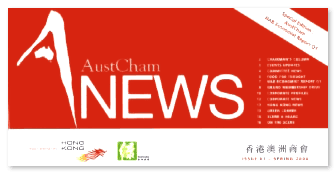
'on the scene'
Australian Chamber of Commerce Hong Kong
PRIORITY ONE TRAINING Business Development Manager Asia Jilly Newgreen is presented with the lucky door prize at the AustCham Hong Kong mix@six - 'where professionals meet professionals'
Jilly can be contacted on 852 9674 4661 or by email jilly_n@priorityonetraining.com.au

'on the scene'
Australian Chamber of Commerce Hong Kong
PRIORITY ONE TRAINING Directors Judy Newgreen and Ian Newgreen attend the AustCham Hong Kong mix@six - 'where professionals meet professionals'
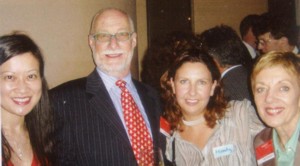
photo left to right:
Suzanne Liu Duddek-S Liu & Co, Ian Newgreen-PRIORITY ONE TRAINING,
Mandy Oakes-Links, Judy Newgreen-PRIORITY ONE TRAINING
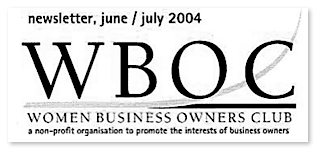
Women Business Owners Club Hong Kong
How to "wow" your audience!
Making a presentation, whether to your staff , your boss, your customers or a room full of 400 people can be a daunting task. As we listened to Sue Rooney and Ian Newgreen at our May meeting, it all sounded so easy and they seemed to be relaxed and enjoying themselves!
Sue suggested it was essential to organise information into what you must cover, what you should cover and what you`ll squeeze in if time allows. Your opening must be strong. Avoid corny jokes unless you have a real talent for humour. Give your audience a "route map" so they know what to expect and where they should be at the end.
Ian used a prop to gain attention and emphasized there importance of making a speech different and memorable. In place of a formal prepared presentation, he spoke eloquently and with passion about topics raised by the audience. He ensured that he covered topics of interest to the meeting, which illustrated the necessity of giving an audience what they want. The most important part of any presentation is the close, so always remain flexible with your content to ensure you have time for a dynamic conclusion.
Although these speakers had contrasting presentation styles, their message was the same: identify your key message, adapt your content to fit your audience and time available, and always prepare a strong and memorable finish.
Sue Dockstader

Australian Chamber of Commerce Hong Kong
Managing Performance - On Going was presented by Judy Newgreen Director of PRIORITY ONE TRAINING at the AustCham lunchtime seminar on 19 February`04
The highly interactive seminar began with participants creating an artistic masterpiece - working in groups, fun was had by all as dazzling pieces of artwork were completed all within four and a half minutes!
The activity demonstrated that when people work together on tasks with time constraints, positive outcomes are achieved through giving feedback to direct efforts, encourage input and recognise performance.
Discussion highlighted the benefits of managing performance through giving feedback resulting in:
| - | supportive and trusting working relationships |
| - | timely recognition of effective performance |
| - | identifying underperformance |
| - | 'no-surprises' formal appraisals |
Real workplace examples were instrumental in emphasising the central
intention of giving feedback.
Participants took away five valuable tips for giving feedback:
1. |
focus on specifics - give actual examples |
2. |
tailor the feedback - use effective interpersonal skills |
3. |
don't get personal - be non-judgemental |
4. |
be constructive - develop a two-way conversation |
5. |
allow the receiver to respond - ask questions and listen actively |
Key message: The feedback that we give may be positive or negative however it should always be constructive.

Australian Chamber of Commerce Hong Kong
Food for Thought
Attendees at a recent the AustCham event were asked what personal improvements they wanted to make to their business presentations .... and the feedback was overwhelming:
| - | build rapport and connection |
| - | keep it simple |
| - | encourage discussion |
| - | be attention catching |
| - | be less nervous |
| - | creative but professionally credible |
Ian Newgreen, Director of PRIORITY ONE TRAINING, who conducted the highly interactive session, says that there are several key tips to consider in developing a presentation:
| - | know your audience |
| - | know your subject & desired outcome |
| - | keep to the time allocated |
| - | practise the presentation - again & again & again …… |
| - | image is important |
| - | perception is more powerful than reality |
| - | look, act and be professional |
When preparing presentations or preparing to make the presentation, there are several things to keep in mind:
| - | grab attention |
| - | create interest |
| - | sell benefits |
| - | think about the audience by asking yourself their magic words ... What's In It For Me otherwise known as WIIFM |
| - | use the power of language |
| - | pace the presentation as is appropriate to the circumstances |
| - | eye contact with the audience |
| - | body language in sync with the spoken words |
| - | gestures to reinforce what you say |
| - | voice - vary the tone, inflection, pace |
| - | visuals as an adjunct to rather than a substitute for, the presenter |
| - | dynamic conclusion |
In summary, Ian said "Your audience demands a professional presentation, as a professional, give them one!"

Aston Ryan & Malcolm Pty Ltd Financial Architects Australia
Business: Performance Management Giving Feedback On-going
the Why
Feedback is a communication skill that is fundamental to how we see ourselves. It's that verbal and non-verbal information that we receive that lets us know what other people think and feel about our appearance, behaviors and performance. Delivered effectively feedback can build self-esteem and self-confidence, encouraging personal and professional growth; delivered poorly, or avoided, it can deflate the ego, promote negative behaviors and decrease levels of performance.
the When
In the workplace feedback is sometimes seen as 'something we have to do when performance appraisals come around'; feedback is often seen by management as a 'difficult task' and viewed apprehensively by staff.
Feedback given on-going throughout the performance cycle, delivered in a timely manner and in supportive environment builds trusting and open relationships that break down the barriers that lead to feedback avoidance.
Feedback should be given to confirm positive behaviors and recognize and reinforce successful performance; feedback should 'nip poor performance in the bud', encouraging and supporting development.
the How
Focus on specifics
| - | be prepared |
| - | give examples of performance, behaviors, attitudes |
| - | link to established goals |
| - | stick to what is relevant |
Tailor the feedback
| - | use effective interpersonal skills |
| - | consciously choose words and body talk |
| - | celebrate achievements |
| - | identify underperformance |
| - | don't get personal |
| - | be assertive |
| - | acknowledge emotions |
| - | be non-judgmental |
| - | build bridges, not walls |
Be constructive
| - | be clear and concise |
| - | develop a two-way conversation |
| - | watch the 'but' |
| - | give feedback in manageable 'chunks' |
Allow the receiver to respond
| - | question and listen |
| - | invite feedback |
| - | allow for perceptions (mine & theirs) |
| - | check attitudes (mine & theirs) |
Feedback can be positive, it can be negative however it should always be constructive.

Aston Ryan & Malcolm Pty Ltd Financial Architects Australia
Business: the Key Tips to a Professional Presentation
"I would rather die than stand up in front of a group of people and speak". By implication - "I would rather be in the coffin than presenting the eulogy".
Key Tips to stay alive!!
Ascertain
| - | who is my audience - why are they attending - what do they want to know |
| - | what is my subject & desired outcome, how do I make it appropriate to the needs of my audience |
| - | what is the presentation timeframe |
| - | what is the forum for my presentation |
| - | what resources will I need |
Create - be Creative
a presentation to achieve the desired outcome for my audience and for me
Practise
the presentation - again & again & again ……
Image
perception is more powerful than reality - look, act and be professional - I am on before I am on
Presentation
| - | grab attention |
| - | create interest |
| - | sell benefits |
| - | think about the audience by asking yourself their magic words ... What's In It For Me otherwise known as WIIFM |
| - | use the power of language |
| - | pace the presentation as is appropriate to the circumstances |
| - | eye contact with the audience |
| - | body language in sync with the spoken words |
| - | gestures to reinforce what you say |
| - | voice - vary the tone, inflection, pace |
| - | visuals as an adjunct to rather than a substitute for, the presenter |
| - | dynamic conclusion |
Evaluate
the plus's and what improvements I can make
Published Articles
News Reports
